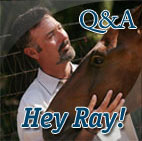The ‘to-do list’ when Fall arrives
 Fall is a great time of year. Temperatures start to decrease, the leaves start to change, and the major holidays are right around the corner. Before life gets away from you with family, don’t forget about your horses. In the fall, there are some routine things that you should be looking at.
Fall is a great time of year. Temperatures start to decrease, the leaves start to change, and the major holidays are right around the corner. Before life gets away from you with family, don’t forget about your horses. In the fall, there are some routine things that you should be looking at.
This time of year, showing is usually still going strong. In order to keep your athlete ready for the task, make sure you are up to date on vaccines and deworming. In the spring, most people get their major vaccines done. Influenza and Rhinopneumonitis vaccines work well, but not for very long. It is estimated that the antibody levels they stimulate subside in seven to eight months. Therefore, it is usually recommended to give a six-month booster in the fall for these two ailments. This vaccine is typically much cheaper than the ones in the spring. There are intramuscular and intranasal products available. Discuss with your veterinarian what will work best for you.
Understanding EPM
 Equine Protozoal Myeloenchephalitis (EPM) is a neurologic disease in horses. It can cause a debilitating disease that can lead a horse down a path of changes that can be difficult to diagnose. In this column, let’s discuss what causes it, how we diagnose it, and how we treat it.
Equine Protozoal Myeloenchephalitis (EPM) is a neurologic disease in horses. It can cause a debilitating disease that can lead a horse down a path of changes that can be difficult to diagnose. In this column, let’s discuss what causes it, how we diagnose it, and how we treat it.
EPM is currently known to be caused by one of two protozoans, Sarcocystis neurona and Neosporoa hughesi. A protozoa is a single-celled organism. S. neurona is the most common cause, and we will focus on this particular organism. In the normal life cycle of the organism, the definitive host — or the one where reproduction of the protozoa occurs — is the opossum. The organism also has an intermediate host which can be a variety of animals, such as certain armadillos, racoons and skunks.
Treating those ‘summer sores’
 The last year in California has been an excellent year for rainfall. For most of the state, the drought has been declared over. With the extra moisture, plants thrived and grew, but so did the bugs. Flies are buzzing us — and our horses. With them comes a nasty skin condition known as cutaneous habronemiasis, more commonly called “summer sores”.
The last year in California has been an excellent year for rainfall. For most of the state, the drought has been declared over. With the extra moisture, plants thrived and grew, but so did the bugs. Flies are buzzing us — and our horses. With them comes a nasty skin condition known as cutaneous habronemiasis, more commonly called “summer sores”.
Hot topic: Summer’s first heat wave
 Summer is here and we are experiencing our first heat wave of the season and it is hot, hot, hot! I think this is a great time to revisit a couple of different subjects we have talked about in the past, dealing with the heat and traveling with our horses.
Summer is here and we are experiencing our first heat wave of the season and it is hot, hot, hot! I think this is a great time to revisit a couple of different subjects we have talked about in the past, dealing with the heat and traveling with our horses.
Let’s start with tips for the heat. In the hot weather, there are some key points to keep in mind to help your horse through the extreme temperatures:
1. Provide access to plenty of fresh, cool, clean water. Horses can consume large quantities of water in the heat to aid in cooling and staying hydrated. Give it to them!
Insurance and horses today
 Insurance. It has become commonplace in today’s society. It has even been legislated into our lives with automobile insurance and health insurance. The idea behind insurance is that many people make small payments into a large pot so that those who need the money for the insured occurrence get a payout for said occurrence.
Insurance. It has become commonplace in today’s society. It has even been legislated into our lives with automobile insurance and health insurance. The idea behind insurance is that many people make small payments into a large pot so that those who need the money for the insured occurrence get a payout for said occurrence.
Well, like almost anything you would like to insure, our pets have insurance available. This includes horses. As medicine advances, it also becomes more expensive. Our pets have newer surgical techniques, advanced imaging modalities, even cutting-edge treatments. All of these things cost more and more money. Society’s view of how we feel and to what lengths we will go for our pets has changed greatly. The length to which we will go to save an animal’s life means we will most likely be spending more money on our animals. Let’s take a peek at what is available to us to help mitigate the higher costs of equine ownership and also protecting the investment we make in these animals.
Equine dentistry
 Equine dentistry has exploded over the past 10 to 15 years. When I was growing up, the veterinarian or the farrier would pull out a couple of hand floats or old rasps and grind down the sharp hooks that develop on the molars and premolars of horses’ teeth. Let’s have a look at the type of teeth horses have and why they need to be floated or filed down.
Equine dentistry has exploded over the past 10 to 15 years. When I was growing up, the veterinarian or the farrier would pull out a couple of hand floats or old rasps and grind down the sharp hooks that develop on the molars and premolars of horses’ teeth. Let’s have a look at the type of teeth horses have and why they need to be floated or filed down.
Horses have what are called hypsodont teeth. These teeth have a large “crown” or top portion of tooth that has enamel. Unlike us, where we have enamel on the outside of our crown only, horses have layers of enamel throughout the crown. This design is great for what horses are intended to eat. Horses are grazers that should be eating roughage for around eighteen hours a day. This roughage is very fibrous and can contain silica or other hard materials that are abrasive and wear down the tooth. Not only are these teeth stronger and able to take the abuse, but horses have what is termed “reserve crown”. This reserve crown is below the gum-line and continuously is erupting throughout the adult life of the horse until it runs out. Usually in their 20s or 30s, the reserve crown is exhausted, and whatever is left is what they have to work with.
A look at complementary medicine
 Medicine, whether veterinary or human, is always evolving. New and ancient modalities are constantly being explored to best serve our patients. What used to be called “eastern medicine” or “alternative medicine”, has now earned the term “complementary medicine”. This month, I thought we might discuss complementary medicine and some of the types we may see in our equine patients.
Medicine, whether veterinary or human, is always evolving. New and ancient modalities are constantly being explored to best serve our patients. What used to be called “eastern medicine” or “alternative medicine”, has now earned the term “complementary medicine”. This month, I thought we might discuss complementary medicine and some of the types we may see in our equine patients.
A chiropractor diagnoses and treats problems with our backs and other areas of the body. In veterinary medicine, the term to this type of practitioner is a Certified Veterinary Medical Manipulation Practitioner (CVMMP). Now, that is a mouthful! CVMMPs adjust the backs, hips, necks and other parts of the body. Often times their additional training makes them excellent at lameness detection. They manipulate various parts of the equine body that may be out of alignment. They do an excellent job at keeping our equine athletes at the top of their game!
What’s in a foal exam – and why?
 Foaling season is upon us. Foals are dropping left and right. From 12 to 24 hours after birth, it is an excellent idea to have your newborn evaluated by your veterinarian. This month, I would like to discuss what I do on my new foal exams and why. I do them in the same order every time so that I do not miss anything. I start at the tail and work my way forward.
Foaling season is upon us. Foals are dropping left and right. From 12 to 24 hours after birth, it is an excellent idea to have your newborn evaluated by your veterinarian. This month, I would like to discuss what I do on my new foal exams and why. I do them in the same order every time so that I do not miss anything. I start at the tail and work my way forward.
Genitalia — The first area I start with. I determine the sex of the foal and examine the external genitalia to make sure things are normal. Does the vulva appear normal if it is a filly? And on the males, are both testes down?
Wet weather woes: the hooves
 We’re in the middle of winter, and a recent question reached me regarding the wet weather and horses’ feet: What kind of issues do we face, and how do we avoid and treat these problems?
We’re in the middle of winter, and a recent question reached me regarding the wet weather and horses’ feet: What kind of issues do we face, and how do we avoid and treat these problems?
With the increased moisture of the season, many areas of the country see an increase in certain problems. The No. 1 problem I encounter that increases with rainy season is hoof abscesses. A hoof abscess is an area of infection that can be found most anywhere in the hoof. They can be closer to the sole or they may try to erupt in the coronary band. In these cases, they are often times called a gravel. For these abscesses, you need three things: 1. bacteria, 2. a medium for them to grow, and 3. the body’s response (pus) to the infection.
An ounce of prevention helps manage equine gastric Ulcers
 Recently we have received questions on gastric (stomach) ulcers. This is a topic that has been and is continuing to be studied extensively. Ulcers occur in a high percentage of horses — anywhere from 38 percent to 88 percent, depending which article you read and depending on the occupation, breed, management, and so forth. In this column, we’ll focus on the symptoms, treatment, and prevention.
Recently we have received questions on gastric (stomach) ulcers. This is a topic that has been and is continuing to be studied extensively. Ulcers occur in a high percentage of horses — anywhere from 38 percent to 88 percent, depending which article you read and depending on the occupation, breed, management, and so forth. In this column, we’ll focus on the symptoms, treatment, and prevention.
First, let’s describe a gastric ulcer. It is a non-healing wound of the lining of the stomach. They can be in the top part of the stomach, which does not secrete stomach acid, or it can be in the lower part of the stomach which does secrete stomach acid. The most common location is at the junction of the two areas, called the margo plicatus. No matter the location, stomach ulcers can be a nagging problem to the horse that can actually get bad enough to perforate and lead to the horse’s death.



 Read Columns
Read Columns

